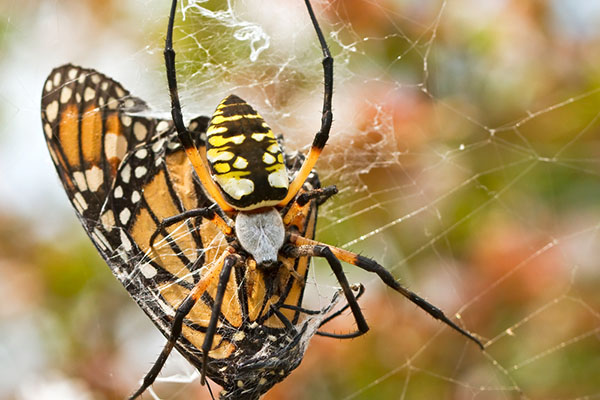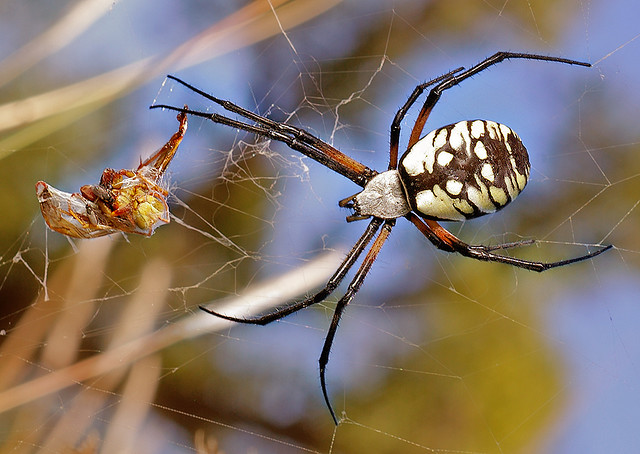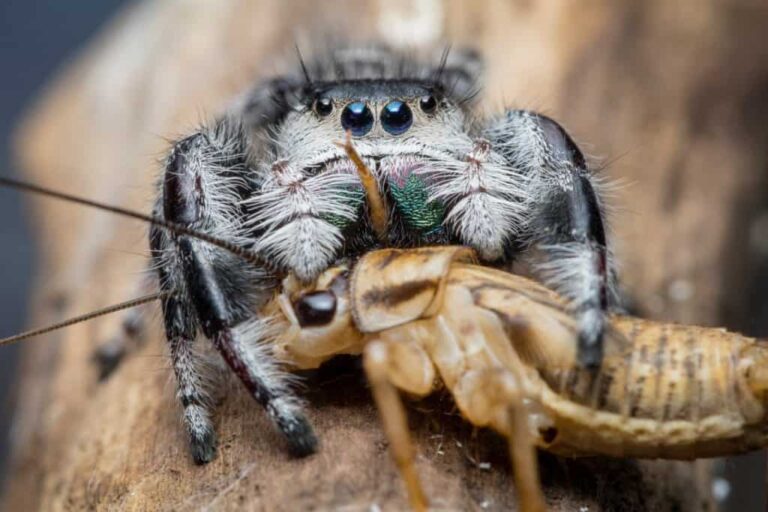Yes, many species of spiders do eat moths. Spiders are carnivorous predators, and their diet typically consists of various insects, including moths. Spiders use a variety of methods to capture their prey, such as building webs, ambushing, or actively hunting.
When a moth or other insect becomes entangled in a spider’s web or comes within the spider’s striking range, the spider will often immobilize it with silk and then proceed to feed on it.
Spiders are well-equipped for capturing and consuming insects, including moths, and they play a vital role in controlling insect populations in ecosystems.
How do spiders catch moths?
The diverse strategies employed by different spider species and the adaptations and behaviors of moths provides a deeper insight into the complex predator-prey interactions in the natural world.
Orb-Weaving Spiders: These spiders are renowned for their intricate, circular webs. They often capture moths when the moths accidentally fly into their webs. Notable examples include the garden orb-weaver and the golden silk orb-weaver.
Jumping Spiders: These agile hunters pounce on their prey, including moths, with remarkable precision. Their keen eyesight and quick reflexes make them effective moth predators. Some jumping spider species are known for mimicking moth-like movements to lure in their prey.
Crab Spiders: These spiders are often found lying in wait on flowers, where they ambush visiting moths and other insects. Their camouflage allows them to blend seamlessly with the flowers they inhabit.
Wolf Spiders: Unlike web-building spiders, wolf spiders are active hunters. They chase down their prey, including moths, using their speed and stealth. Some wolf spider species are known for their maternal care, carrying their spiderlings on their backs.
Trapdoor Spiders: These spiders construct burrows with hinged lids. When a moth or other prey item ventures too close, the spider quickly lunges out of its burrow to seize the unsuspecting prey.
Explanation of spider hunting techniques

Web Construction: Orb-weaving spiders create intricate, sticky webs to ensnare flying insects like moths. They wait in the center or at the periphery of the web for vibrations caused by trapped prey.
Ambush and Pouncing: Jumping spiders use their excellent vision to spot moths from a distance. They stalk and then pounce on their prey, using silk threads as safety lines in case they miss.
Camouflage: Crab spiders rely on their ability to blend in with flowers, waiting patiently for moths to approach while they remain hidden among petals.
Chasing Down Prey: Wolf spiders actively chase and pounce on moths and other insects. They rely on their speed and stealth to capture prey.
Burrow Ambush: Trapdoor spiders hide in burrows lined with silk and wait for moths to wander close. When a moth approaches, they burst out of their burrow to capture it.
How do moths avoid spiders?
Most moths are nocturnal, flying at night. This behavior reduces their chances of encountering diurnal predators like birds. Moths are often attracted to artificial lights, which can sometimes lead to their unintended encounters with spiders.
In addition, moths exhibit distinctive flight patterns, often fluttering in a zigzag or spiral path, which can make them challenging targets for predators.
How moths detect and respond to spider threats
Moths have sensitive antennae that can detect chemical cues and vibrations in the air, helping them sense the presence of nearby predators, including spiders.
Furthermore, when moths detect a potential threat, they may change their flight pattern erratically to evade capture. Some species can emit pheromones to confuse predators or potential mates.
Some moths have evolved camouflage patterns and colors that make them less conspicuous to predators like spiders.
In addition, moths may employ rapid take-off maneuvers to escape from spider silk, or they may use their scales to shed themselves from a sticky web.
What happens when spiders and moths meet?
The interaction between spiders and moths represents a classic predator-prey relationship in ecology. Spiders are the predators, and moths are the prey.
Spiders have evolved various strategies to capture and consume moths, while moths have developed defensive mechanisms to evade predation.
Over time, this relationship has led to co-evolutionary dynamics where both predators (spiders) and prey (moths) adapt to each other’s strategies. For example, some moths have evolved behaviors that allow them to detect and avoid spider silk.
Factors influencing successful moth predation
The type and location of a spider’s web can greatly influence its success in capturing moths. Orb-weaving spiders strategically position their webs in areas with high moth traffic, such as near light sources or in gardens.
Larger spider species may be more successful in capturing larger moth species. The specific hunting techniques of different spider species also play a role.
Moth size, flight pattern, and behavior (e.g., erratic flight or attraction to light) can affect their vulnerability to spider predation.
Nocturnal moths are more vulnerable to spider predation at night, whereas diurnal moths may face threats from birds and other predators.
How do spiders capture moths?
Many spiders possess venomous fangs that inject toxins into their prey, paralyzing or killing moths swiftly.
Spiders use silk not only to build webs but also to wrap their captured moths securely. This immobilizes the prey and prevents escape.
Spiders have specialized mouthparts that allow them to feed on liquefied prey. They can suck out the internal fluids of moths after immobilizing them.
Specialized silk and web structures
Some spiders produce silk with adhesive properties to capture flying insects like moths. The silk’s stickiness traps moths upon contact.
Furthermore, orb-weaving spiders construct intricate, circular webs designed to intercept and capture moths as they fly into or near the web.
In addition, some spiders build funnel-shaped webs with a retreat at the narrow end. These webs are strategically placed to ambush moths that wander into the funnel.
Venom and immobilization strategies
Spiders have evolved a diverse range of venoms, some of which are tailored to specific prey types, including moths. Venom can paralyze or subdue moths quickly.
After a moth is captured, spiders often use silk to wrap it tightly, preventing any movement. This immobilization ensures that the prey cannot escape or struggle.
Some spiders inject digestive enzymes into their prey to break down internal tissues, allowing them to suck out the liquefied contents.
How do moths defend against spiders?
Some moths produce ultrasonic sounds as a defense mechanism. These sounds can disrupt a spider’s ability to locate and capture them, as spiders primarily rely on vibrations and sensory cues.
Certain moths have developed chemical defenses, such as toxic compounds or bad-tasting secretions, that deter spiders and other predators from consuming them. This is akin to chemical warfare in the animal kingdom.
In addition, some moth species have evolved to mimic unpalatable or toxic insects, making them less appealing prey for spiders. For example, some moths mimic wasps or ants, which are known for their stinging defenses.
Camouflage and defensive behaviors
Many moths have evolved cryptic coloration that allows them to blend in with their surroundings. This camouflage helps them avoid visual detection by predators, including spiders.
Some moths adopt defensive postures when threatened, such as spreading their wings to display eye-like patterns or flash bright colors to startle or confuse predators.
Moths often exhibit evasive flight patterns when confronted by a potential threat, making it challenging for spiders to predict their movements and capture them.
Coevolutionary dynamics between moths and spiders
The interactions between moths and spiders represent an evolutionary arms race. As moths develop new defensive strategies, spiders evolve counter-strategies to capture them effectively.
Moreover, these interactions exert selective pressures on both moths and spiders, leading to the evolution of diverse traits and behaviors. For example, moths with effective escape mechanisms are more likely to survive and reproduce.
Coevolution has led to the diversity of moth species with various defensive adaptations and the diversity of spider species with specialized hunting techniques.
Why do spiders matter for moths?

Spiders play a crucial role in regulating moth populations. Their predation helps control moth numbers, preventing outbreaks that could have ecological consequences.
Spider predation can exert selective pressure on moth populations, favoring the survival of moths with effective defensive adaptations.
Role of moths in ecosystems
Many moth species are important pollinators, especially for night-blooming flowers. Their role in pollination contributes to the reproduction of various plant species.
Moths serve as a significant food source for various predators, including bats, birds, and other insects. Their presence in food webs supports the biodiversity of ecosystems.
Moth caterpillars, in their larval stage, contribute to nutrient cycling by feeding on plant material and aiding in decomposition.
Balancing predator-prey relationships in nature
Predator-prey relationships, such as those between moths and spiders, contribute to the maintenance of biodiversity by preventing any one species from dominating an ecosystem.
Moreover, these relationships help stabilize ecosystems by preventing population explosions of certain species, which can have cascading effects on other organisms.
Furthermore, the ongoing interactions between predators and prey drive adaptation and evolution, leading to the development of a wide array of traits and strategies in both predator and prey species.
FAQ’s
Which Colour is a spider’s blood?
A spider’s blood, called hemolymph, is typically pale blue or greenish in color.
Who is the king of spiders?
Spiders do not have a king or central authority figure, as they are not social insects like ants or bees. They are solitary creatures.
Which animal has blue blood?
Some animals with blue blood include certain species of horseshoe crabs and certain marine arthropods. They have blue blood due to the presence of copper-based hemocyanin.
Who has blue blood in humans?
In humans, the term “blue blood” is often used metaphorically to refer to nobility or the aristocracy rather than the actual color of blood.
Which animal has purple blood?
Some species of sea squirts (tunicates) have blood that appears purple due to the presence of vanadium in their blood pigment, vanabin.
Who is the queen of spiders?
Similar to kings, spiders do not have queens as they are typically solitary creatures. In social spider species, there may be a dominant female, but she is not referred to as a queen.
Who is most afraid of spiders?
Arachnophobia, or the fear of spiders, is a common phobia among humans. Many people experience varying degrees of fear or discomfort when encountering spiders.
Final Thought
In conclusion, the intricate and age-old predator-prey relationship between spiders and moths reveals a captivating glimpse into the world of natural interactions. Throughout this exploration, we have delved into the various strategies employed by both spiders and moths, shedding light on the evolution of remarkable adaptations in their ongoing struggle for survival.
From the spiders’ venomous fangs and finely-tuned silk structures to the moths’ ingenious defenses and evasive behaviors, these creatures have engaged in a ceaseless evolutionary arms race.
Moreover, these interactions are not just a spectacle of nature; they hold significant ecological implications. Spiders play a vital role in regulating moth populations, thus contributing to the balance and biodiversity of ecosystems. Meanwhile, moths serve as both pollinators and essential links in the food web.

